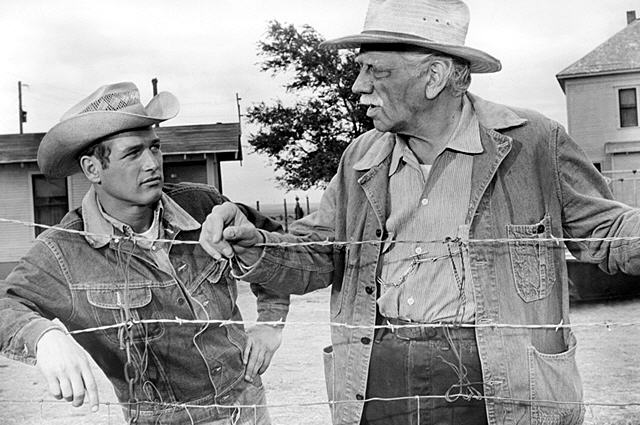ファイル:Paul Newman and Melvyn Douglas Hud.jpg
Paul_Newman_and_Melvyn_Douglas_Hud.jpg (640 × 425 ピクセル、ファイルサイズ: 64キロバイト、MIME タイプ: image/jpeg)
ウィキメディア・コモンズのファイルページにある説明を、以下に表示します。
|
概要
| 解説Paul Newman and Melvyn Douglas Hud.jpg |
English: Paul Newman and Melvyn Douglas in "Hud" |
| 日付 | |
| 原典 | http://wazzasplace.blogspot.de/2008/09/paul-newman-another-cool-dude-gone.html |
| 作者 | Paramount Pictures |
| 許可 (ファイルの再利用) |
Creative Clearance offers similar advice for older publicity stills but distinguishes "Publicity Photos (star headshots)" from "Production Stills (photos taken on the set of the film or TV show during the shooting)". It says newer publicity stills may contain a copyright, and production stills "must be cleared with the studio."[2] Nancy Wolff, includes a similar explanation: Legal expert on the use of photographic images, Nancy Wolff, includes a similar explanation:
These photographs came from a photo archive of entertainment industry publicity pictures, historic still images widely distributed by the studios to advertise and promote their then new releases. While not considered valuable at the time, avid collectors have created complete archives by salvaging and cataloging movie and television photographs, preserving a significant facet of American culture. These archives are a valuable cache for publishers who rely on these archives as a resource for entertainment material."[3] Film industry author Gerald Mast, in Film Study and the Copyright Law (1989) p. 87, writes: Film industry expert Gerald Mast explains how the new 1989 copyright revisions only protected publicity works that complied with all earlier requirements in addition to filing a copyright registration within 5 years of first publication:
|
ライセンス
| Public domainPublic domainfalsefalse |
この著作物は、アメリカ合衆国で1929年から1977年の間に発行され、それに加え、著作権表示がされていなかったため、パブリックドメインの状態にあります。著作者が死亡して十分な年月が経った場合でない限り、カナダ(著作者の死後50年)、中国本土(著作者の死後50年、香港とマカオを除く)、ドイツ(著作者の死後70年)、メキシコ(著作者の死後100年)、スイス(著作者の死後70年)、そして個別的に条約を締結している国々のように、米国の著作物についてその保護期間に関して相互主義を採用していない国や地域では、パブリックドメインの状態にはありません。詳細は、このページを参照してください。
العربية ∙ беларуская (тарашкевіца) ∙ čeština ∙ Deutsch ∙ Ελληνικά ∙ English ∙ español ∙ français ∙ Bahasa Indonesia ∙ italiano ∙ 日本語 ∙ 한국어 ∙ македонски ∙ Nederlands ∙ português ∙ русский ∙ sicilianu ∙ slovenščina ∙ ไทย ∙ Tiếng Việt ∙ 中文(简体) ∙ 中文(繁體) ∙ +/− |
References
- ↑ Honathaner, Eve Light. The Complete Film Production Handbook, Focal Press, (2001) p. 211
- ↑ Creative Clearance. Photography Clearance. Clearance Guidelines for Producers. Archived from the original on 2013-02-12. Retrieved on 4 May 2011.
- ↑ Wolff, Nancy E. The Professional Photographer's Legal Handbook, Allworth Communications, 2007 p. 55
- ↑ Mast, Gerald. "Film Study and the Copyright Law", from Cinema Journal, Winter 2007, pp. 120-127
- ↑ Thompson, Kristin. [1] "Report of the Ad Hoc Committee of the Society For Cinema Studies, "Fair Usage Publication of Film Stills" "Society for Cinema and Media Studies", 1993 conference
ファイルの履歴
過去の版のファイルを表示するには、その版の日時をクリックしてください。
| 日付と時刻 | サムネイル | 寸法 | 利用者 | コメント | |
|---|---|---|---|---|---|
| 現在の版 | 2014年1月7日 (火) 17:20 |  | 640 × 425 (64キロバイト) | GDuwen | User created page with UploadWizard |
ファイルの使用状況
以下のページがこのファイルを使用しています:
グローバルなファイル使用状況
以下に挙げる他のウィキがこの画像を使っています:
- el.wikipedia.org での使用状況
- en.wikipedia.org での使用状況
- fr.wikipedia.org での使用状況
- hyw.wikipedia.org での使用状況
- sr.wikipedia.org での使用状況
メタデータ
このファイルには、追加情報があります (おそらく、作成やデジタル化する際に使用したデジタルカメラやスキャナーが追加したものです)。
このファイルが元の状態から変更されている場合、修正されたファイルを完全に反映していない項目がある場合があります。
| JPEGファイルのコメント | LEAD Technologies Inc. V1.01 |
|---|


